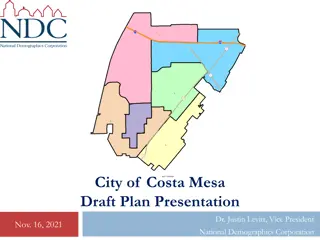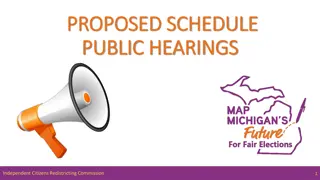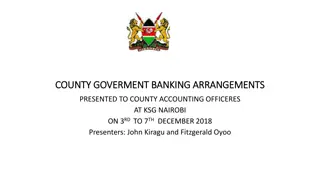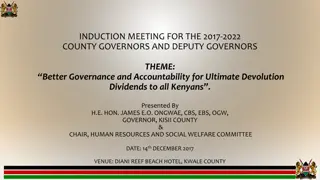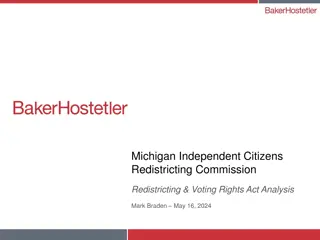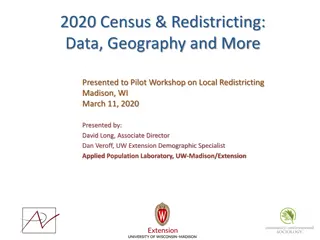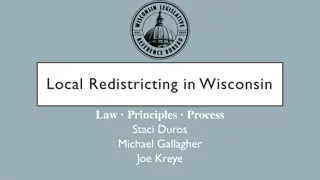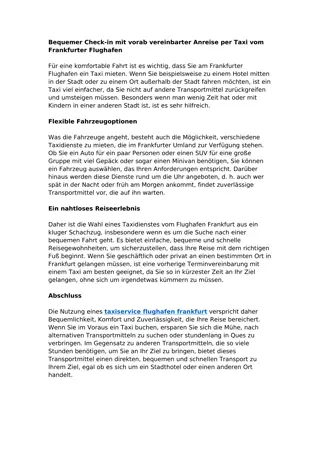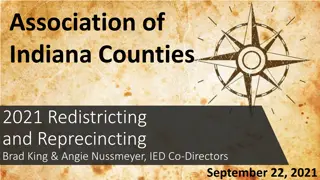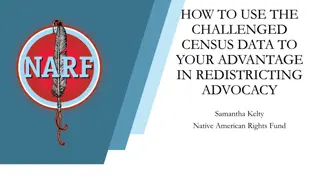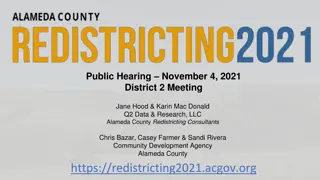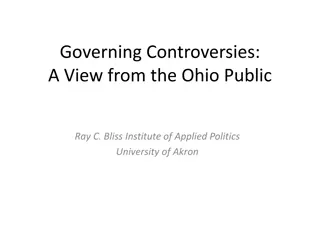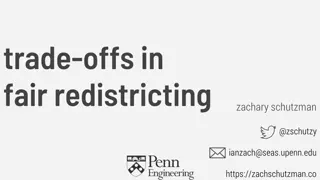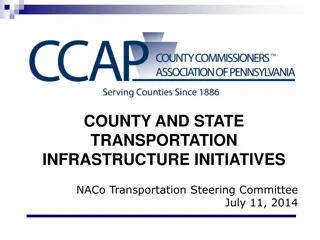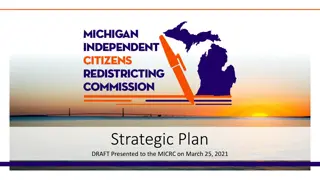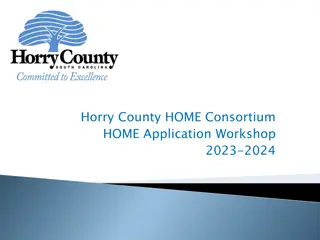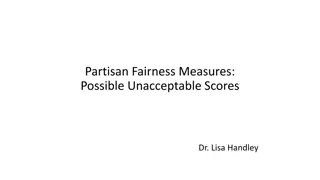Understanding Redistricting Process in Lassen County
Redistricting in Lassen County is crucial for ensuring equal representation by redrawing supervisorial district boundaries based on population data. The Board of Supervisors is responsible for this process, which is guided by specific criteria to uphold constitutional requirements and consider local communities of interest. With the delay in 2020 Census data release, the redistricting timeline has been adjusted.
Download Presentation

Please find below an Image/Link to download the presentation.
The content on the website is provided AS IS for your information and personal use only. It may not be sold, licensed, or shared on other websites without obtaining consent from the author. Download presentation by click this link. If you encounter any issues during the download, it is possible that the publisher has removed the file from their server.
E N D
Presentation Transcript
Lassen County REDISTRICTING 2020
Every ten years, districts must be redrawn so that each district is substantially equal in population. This process, called redistricting, is important in ensuring that each board member represents about the same number of constituents. In Lassen County, the Board of Supervisors is responsible for drawing supervisorial districts. Redistricting is done using U.S. Census data, which would have been typically released around March 31, 2021. However due to Covid-19 restraints 2020 Census Data will not be released until mid to late September. What is Redistricting?
21500. (a) Following a county s decision to elect its board using district-based elections, or following each federal decennial census for a county whose board is already elected using district-based elections, the board shall adopt boundaries for all of the supervisorial districts of the county so that the supervisorial districts shall be substantially equal in population as required by the United States Constitution. (1) Population equality shall be based on the total population of residents of the county as determined by the most recent federal decennial census for which the redistricting data described in Public Law 94-171 are available. (2) Notwithstanding paragraph (1), an incarcerated person, as that term is used in Section 21003, shall not be counted towards a county s population, except for an incarcerated person whose last known place of residence may be assigned to a census block in the county, if information about the last known place of residence for incarcerated persons is included in the computerized database for redistricting that is developed in accordance with subdivision (b) of Section 8253 of the Government Code, and that database is made publicly available. Elections Code 21500
21500. b)The board shall adopt supervisorial district boundaries that comply with the United States Constitution, the California Constitution, and the federal Voting Rights Act of 1965 (52 U.S.C. Sec. 10301 et seq.). (c)The board shall adopt supervisorial district boundaries using the following criteria as set forth in the following order of priority: (1)To the extent practicable, supervisorial districts shall be geographically contiguous.Areas that meet only at the points of adjoining corners are not contiguous. Areas that are separated by water and not connected by a bridge, tunnel, or regular ferry service are not contiguous. (2)To the extent practicable, the geographic integrity of any local neighborhood or local community of interest shall be respected in a manner that minimizes its division. A community of interest is a population that shares common social or economic interests that should be included within a single supervisorial district for purposes of its effective and fair representation. Communities of interest do not include relationships with political parties, incumbents, or political candidates. (3)To the extent practicable, the geographic integrity of a city or census designated place shall be respected in a manner that minimizes its division. Elections Code 21500 (continued)
21500. (4)Supervisorial district boundaries should be easily identifiable and understandable by residents. To the extent practicable, supervisorial districts shall be bounded by natural and artificial barriers, by streets, or by the boundaries of the county. (5)To the extent practicable, and where it does not conflict with the preceding criteria in this subdivision, supervisorial districts shall be drawn to encourage geographical compactness in a manner that nearby areas of population are not bypassed in favor of more distant populations. (d)The board shall not adopt supervisorial district boundaries for the purpose of favoring or discriminating against a political party. Elections Code 21500 (continued)
1 Initial Board Discussion April 27, 2021 2 Create Website & Begin Public Outreach Spring 2021 3 Pre-Draft Map : public forum(s) and hearings(s) Summer 2021 4 Census Bureau population counts, demographic data 09/30/2021 Step-by-Step Timeline 5 SWDB releases prison adjusted counties; release of public participation tools 10/29/2021 6 Publish draft maps(note: maps cannot be published for one week if adjusted database received before 10/16/2021) 11/5/2021 7 Public hearing(s) on draft maps At least two Initial Draft Time-Line 8 Published revised map(s) 7 days prior to adoption 9 Final Hearing and Adoption (Leave Time for second reading if adopting by ordinance) 10 Current legal deadline to adopt (Registrars pushing for earlier completion) 12/15/2021 (E-174) 11 Candidate in-lieu petition forms (date can slide for each day plan is E-173 (12/16/2021)E-113 12 Election June 2022
STATE LAW PROCESS Drawing the Lines-Legal Considerations Hearings, Record Keeping, Public Outreach
THEN: 2010 Census One public hearing on the proposal prior to the public hearing at which the governing body votes to approve or defeat the proposal. HEARINGS NOW: 2020 Census At least four public hearings: at least one before draft maps are drawn. At least two after draft maps are drawn; at least one on a Saturday, Sunday or after 6:00P.M. Monday through Friday Then & Now
Date, time and location must be posted online at least five days before the hearing or workshop. Hearings must be conducted at a time certain. No maps published until three weeks (21 day waiting period) after release of the prisoner-adjusted database. Only one week if 60-90 days remaining until deadline, and waived if fewer than 60 days) Hearings to identify communities of interest can begin before Census data is received.
THEN: 2010 Census None specifically required. RECORD KEEPING NOW: 2020 Census Record of every public comment and governing body made available to the public within two weeks. Webpage maintained for 10 years. Then & Now
An explanation of the redistricting process Procedures for testifying or submitting written testimony Calendar of all hearings and workshops Notice and agenda for each hearing and workshops Recording or written summary of each hearing and workshop All draft maps & adopted map
THEN: 2010 Census Compliance with Brown Act. PUBLIC OUTREACH NOW: 2020 Census Jurisdiction must encourage public participation through : Then & Now
Media outreach. Good government, civil rights, civic engagement & community groups. Live translation, if requested 72 hours in advance of meeting. Publication of notices on the internet. Publication of notices of required public hearings five days before hearing. Publication of a draft map at least seven days before adoption. Publication of relevant demographic data. Receipt of maps or testimony from the public in writing or electronically.
Other than equal population, Voting Rights Act, and equal protection, criteria were formerly discretionary and permissive (the board may consider the others). Now appear mandatory. Criteria now ranked in order of priority. No longer clear that non-statutory criteria can be considered. Consideration of incumbency and political parties now restricted to what extent, unclear. Exclusion of prisoners previously a policy choice; not now. State Law Criteria: What s Changed?




